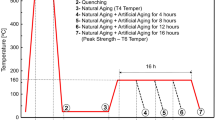Abstract
The assessment or prediction of fatigue life or strength improvement due to residual stresses requires knowledge of their magnitude and distribution. This paper presents an extension of the modified hole-drilling technique (MHDT) to the measurement of stress gradients in a biaxial-residual-stress field. This is achieved by taking a series of ‘point’ measurements and evaluating the stress profile with due consideration to the effects of hole location, the interaction between holes and the redistribution of stress due to hole drilling.
An application to the measurement of residual stresses induced in 2024-T3 aluminum-alloy specimens by edge-dimpling technique is described and the method of compensation for the effect of redistribution of stress is explained. The experimental results are shown to be in good agreement with those obtained elsewhere by an analytic-numerical solution.
Similar content being viewed by others
Abbreviations
- A, B :
-
components of the relaxation coefficients dimensionless
- d :
-
hole size, in. (mm)
- E :
-
elasticity modulus, psi (MPa)
- K r (λ, θ):
-
radial-relaxation coefficient, dimensionless
- \(\bar K_r (\lambda ,\theta )\) :
-
equivalent relaxation coefficient in biaxial-stress measurement, dimensionless
- K θ (λ, θ):
-
tangential relaxation coefficient, dimensionless
- r :
-
distance from the hole center to strain-gage center, in. (mm)
- α(λ):
-
ratio of relaxation coefficients =\(K_r (\lambda ,\frac{\pi }{2})/(\lambda ,0)\)
- β:
-
biaxiality ratio
- ε:
-
strain, in./in. (m/m)
- ∈ R :
-
net relaxation strain
- ∈ Ri :
-
net relaxation strain for gagei=a,b orc
- ∈ Rx , ∈ Ry :
-
net relaxation strain inx andy directions, respectively
- △∈ x , △∈ y :
-
changes in strain inx andy directions, respectively
- θ:
-
angle between the direction of stress and the direction of measurement, deg
- λ:
-
parameter defined byd/r, dimensionless
- ν:
-
Poisson's ratio
- σ:
-
stress, psi (MPa)
- σ x , σ y :
-
stresses in thex andy directions, respectively
- △σ x , △σ y :
-
changes in σ x and σ y respectively
- \(\sigma _x ^\prime \) :
-
remaining residual stress in thex direction
- \(\vartriangle \sigma _x ^\prime \) :
-
change in\(\sigma _x ^\prime \)
- \(\sigma _x ^{\prime \prime } \) :
-
stress easured
References
Martin, D.L., ed., “Evaluation of Methods for the Measurement of Residual Stresses,” SAE TR-147 (1960).
Nawwar, A.M., McLachlan, K. andShewchuk, J., “A Modified Hole-drilling Technique for Determining Residual Stresses in Thin Plates,”Experimental Mechanics,16 (6),226–232 (Jun. 1976).
Kelsey, R.A., “Measuring Non-uniform Residual Stresses by Hole-drilling Method,”Proc. SESA,14 (1),181–194 (1956).
Savin, G.N., Stress Concentration Around Holes, Pergamon Press, (Trans. from Russian) (1961).
Peterson, R.E., Stress Concentration Factors, John Wiley (1974).
Cordiano, H.V. andSalerno, V.L., “Study of Residual Stresses in Linearly Varying Biaxial-stress Fields,”Experimental Mechanics,9(1),17–24 (Jan. 1969).
Nawwar, A.M., Shewchuk, J. andLloyd, D.J., “The Improvement of Fatigue Strength by Edge Treatment,”Experimental Mechanics,15(5),161–168 (May 1975).
Nawwar, A.M., PhD Thesis, University of Manitoba, Canada (Oct. 1976).
Author information
Authors and Affiliations
Rights and permissions
About this article
Cite this article
Nawwar, A.M., Shewchuk, J. On the measurement of residual-stress gradients in aluminum-alloy specimens. Experimental Mechanics 18, 269–276 (1978). https://doi.org/10.1007/BF02324168
Received:
Revised:
Issue Date:
DOI: https://doi.org/10.1007/BF02324168




